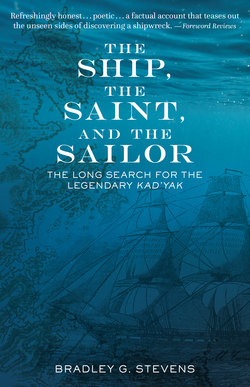Читать книгу The Ship, the Saint, and the Sailor - Bradley G. Stevens - Страница 15
На сайте Литреса книга снята с продажи.
ОглавлениеCHAPTER 8
SERENDIPITY
AND
REVELATION
MAY 2003: ONE DAY I stopped at the local video store to return a movie and ran into Josh Lewis, my daughter’s sixth grade science teacher. Standing on the street corner, we started talking about diving. He was a diver and had been doing some exploration of recent wrecks on the west side of Kodiak with a friend of his named Steve Lloyd, who owned a bookstore in Anchorage. When I told him about my interest in the Kad’yak, he offered the use of his boat and several volunteer divers to go search for it. Together, standing on the sidewalk, we hatched a plan.
My spirits were high now that I had a diving schedule to look forward to. At last, I would get the chance to look for the Kad’yak.
JUNE 2003
I spent the first part of this month visiting NOAA headquarters in Silver Spring, MD, to arrange my temporary assignment there, and look for housing. Over the past month, Josh and I had grown more excited about the Kad’yak as we developed our plans. We were going to visit Icon Bay and dive over three days, July 20–22. In order not to jeopardize my job, I would take those days off and do the work on my vacation time. Besides myself, Josh, and Steve, the team would include a select group of divers. At the top of the list were Mark Blakeslee and Bill Donaldson, and local dive shop owner Verlin Pherson. We also invited Stefan Quinth; he was also a scuba diver and wanted to document the discovery process, if we found the ship. Since this was a volunteer operation, we would have to rent tanks from Verlin as opposed to using NOAA gear. To say I was greatly excited about the prospects would be the understatement of the year.
Underlying all the excitement, a dilemma bubbled to the surface. I was a scientist, well known in Alaska and especially in Kodiak. If I undertook an expedition to find the Kad’yak, it had to be completely above suspicion. I couldn’t have anyone think that I was doing it for personal profit or aggrandizement. I had tried to do it the right way for years, teaming up with professional archaeologists and writing proposals, but nothing had come of it. Here was an opportunity to do it on the cheap. No proposal, no budget, nobody looking over my shoulder. Just hop on the boat with Josh and go do it. It was simple, direct, and appealing. But it was also wrong. Even if we found the Kad’yak, I would be a target for criticism. There was only one way to make this work, and that was to make sure that Dave McMahan was involved and the search was sanctioned by the state. Direct participation by the state archaeologist would ensure the state that any discoveries would be handled responsibly and within the law, and would negate the need for a permitting process to involve another credentialed archaeologist. At the first opportunity, I called and invited him to join us for the trip. He said he wouldn’t miss it for the world.
With the date for our trip to Icon Bay rapidly approaching, I still did not have a good location for the Kad’yak. In preparation for the trip, I spent much of my time replotting all of Arkhimandritov’s bearings. I had done this so many times before that I lost count, but it was always on paper. Now I was using a computerized navigation program that made it a lot easier, because if I was not satisfied with the lines and points, I could just move them around.
THE BEARINGS RECORDED BY THE captain were difficult to interpret for three reasons. First, he did not make them using 360-degree compass notations but rather quadrants. One of his first bearings was recorded from the “south point of Ostrov Elevoi,” or Spruce Island, and was “5 degrees SW” to the right promontory of Monashka Bay. Fortunately, that location was still labeled “South Point” on the NOAA navigation chart that I was using, so I had a good estimate of his starting position. But the bearing could have four different meanings: It could mean five degrees west of South (185 degrees), five degrees south of West (265 degrees), or five degrees from Southwest (220 to 230 degrees). Over several months, I had consulted sailing manuals, Bowditch (Nathaniel Bowditch’s navigation manual), and every historical document I could find regarding sailing, but I never came across any similar manner of recording bearings. Finally I decided that South would be the most prominent direction on the compass, and the bearing should be west of that, or 185 degrees.
Second, I assumed that Arkhimandritov’s recorded bearings were magnetic rather than true bearings. Mariners have always used compasses to determine their direction, but compasses are magnetic and thus susceptible to variations in the earth’s magnetic field. Depending on your location on earth, a compass may point anywhere from a few degrees to tens of degrees away from true north. This difference, referred to as magnetic variation or declination, changed annually. The magnetic variation near Kodiak was now 19.5 degrees, but what was it in 1860, when Arkhimandritov took these bearings? Although compasses can be adjusted to read true north, it is unlikely that Arkhmandritov had such a compass with him as he surveyed the coastline of Spruce Island in a kayak.
